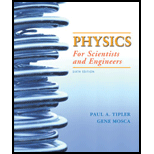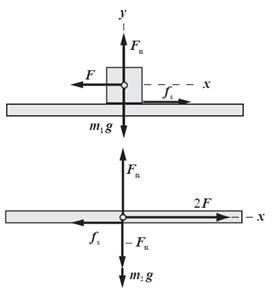
Concept explainers
(a)
The maximum force which is applied so that there is no relative motion between block and bracket.
(a)
Explanation of Solution
Given:
Mass of the block is
Mass of the bracket is
Value of the static friction is
Value of the kinetic friction is
Formula used:
Draw free body diagram of block and bracket.

Write expression for net force in x -direction on block.
Substitute
Here,
Substitute
Here,
Rearrange above expression for
Write expression for net force in x -direction on block.
Substitute
Here,
Substitute
Calculation:
Substitute
Substitute
Conclusion:
Thus, the maximum force is
(a)
The maximum force which is applied so that there is no relative motion between block and bracket.
(a)
Explanation of Solution
Given:
Mass of the block is
Mass of the bracket is
Value of the static friction is
Value of the kinetic friction is
Formula used:
Draw free body diagram of block and bracket.

Write expression for net force in x -direction on block.
Substitute
Substitute
Rearrange above expression for
Write expression for net force in x -direction on block.
Substitute
Substitute
Calculation:
Substitute
Conclusion:
The acceleration of the block is equal to the acceleration of the bracket. Thus, the acceleration of the bracket is
Want to see more full solutions like this?
Chapter 5 Solutions
Physics For Scientists And Engineers
- Calculate the maximum acceleration of a car that is heading up a 4.00slope (one that makes an angle of 4.00with the horizontal) under the following road conditions. Assume that only half the weight of the car is supported by the two drive wheels and that the coefficient of static friction is involved—that is, the tires are not allowed to slip during the acceleration. (Ignore rolling.) (a) On wet concrete. (b) On wet concrete. (C) On ice, assuming that s=0.100 , the same as for shoes on ice.arrow_forwardJamal and Dayo are lifting a large chest, weighing 207 lb, by using the two rope handles attached to either side. As they lift and hold it up so that it is motionless, each handle makes a different angle with respect to the vertical side of the chest (Fig. P5.76). If the angle between Jamals handle and the vertical side is 25.0 and the angle between Dayos handle and the vertical side of the chest is 30.0, what are the tensions in each handle? FIGURE P5.76arrow_forwardShow that, as explained in the text, a force F exerted on a flexible medium at its center and perpendicular to its length (such as on the tightrope wire in Figure 5.26) gives rise to a tension of magnitude T=F/2sin() .arrow_forward
- A hiker who has broken his forearm rigs a temporary sling using a cordstretching from his shoulder to his hand. The cord holds the forearmlevel and makes an angle of 40.0° with the horizontal where it attachesto the hand. Considering the forearm and hand to be uniform, with atotal mass of 1.30 kg and a length of 0.300 m, find (a) the tension inthe cord and (b) the horizontal and vertical components of the force, f>,exerted by the humerus (the bone of the upper arm) on the radius andulna (the bones of the forearm).arrow_forward7.6 Determine the smallest angle θ at which the uniform triangular plate of weight W can remain at rest. The coefficient of static friction at A and B is 0.5.arrow_forwardIn about 1915, Henry Sincosky of Philadelphia suspended himself from a rafter by gripping the rafter with the thumb of each hand on one side and the fingers on the other side (see the figure). Sincosky's mass was 79.0 kg. If the coefficient of static friction between hand and rafter was 0.720, what was the least magnitude of the normal force on the rafter from each thumb or opposite fingers?arrow_forward
- In comparing two unequal forces on a rigid body, is it possible to have the larger force produce lesstorque than the smaller force?a. Yes b. Noarrow_forwardWhat would be the maximum weight W of the block, shown in the following figure, so that the tension developed in any cable does not exeed 100 Narrow_forwardShow that, as explained in the text, a force F⊥ exerted on a flexible medium at its center and perpendicular to its length (such as on the tightrope wire in Figure 5.26) gives rise to a tension of magnitude T = F⊥ /2sin(θ) .arrow_forward
- Body A has a weight/force of 441.45N and the coefficient for Body A, Body B and ramp C is 0.10. What is the smallest mass of B to make the system in equilibrium while neglecting the friction between the string and the ramp? Show the complete solution and the FBD. Answer should be: 23.92arrow_forwardA woman weighing 580 N does a pushup from her knees, as shown. What are the normal forces of the floor on (a) each of her hands and (b) each of her knees?arrow_forwardThe leg and cast in fig p4.40 weight 220n (w1) ,Determine the weight w2 and the angle ∝ needed so that no force is exeted on the hip joinby the leg plus the castarrow_forward
 University Physics Volume 1PhysicsISBN:9781938168277Author:William Moebs, Samuel J. Ling, Jeff SannyPublisher:OpenStax - Rice University
University Physics Volume 1PhysicsISBN:9781938168277Author:William Moebs, Samuel J. Ling, Jeff SannyPublisher:OpenStax - Rice University Physics for Scientists and Engineers: Foundations...PhysicsISBN:9781133939146Author:Katz, Debora M.Publisher:Cengage Learning
Physics for Scientists and Engineers: Foundations...PhysicsISBN:9781133939146Author:Katz, Debora M.Publisher:Cengage Learning

